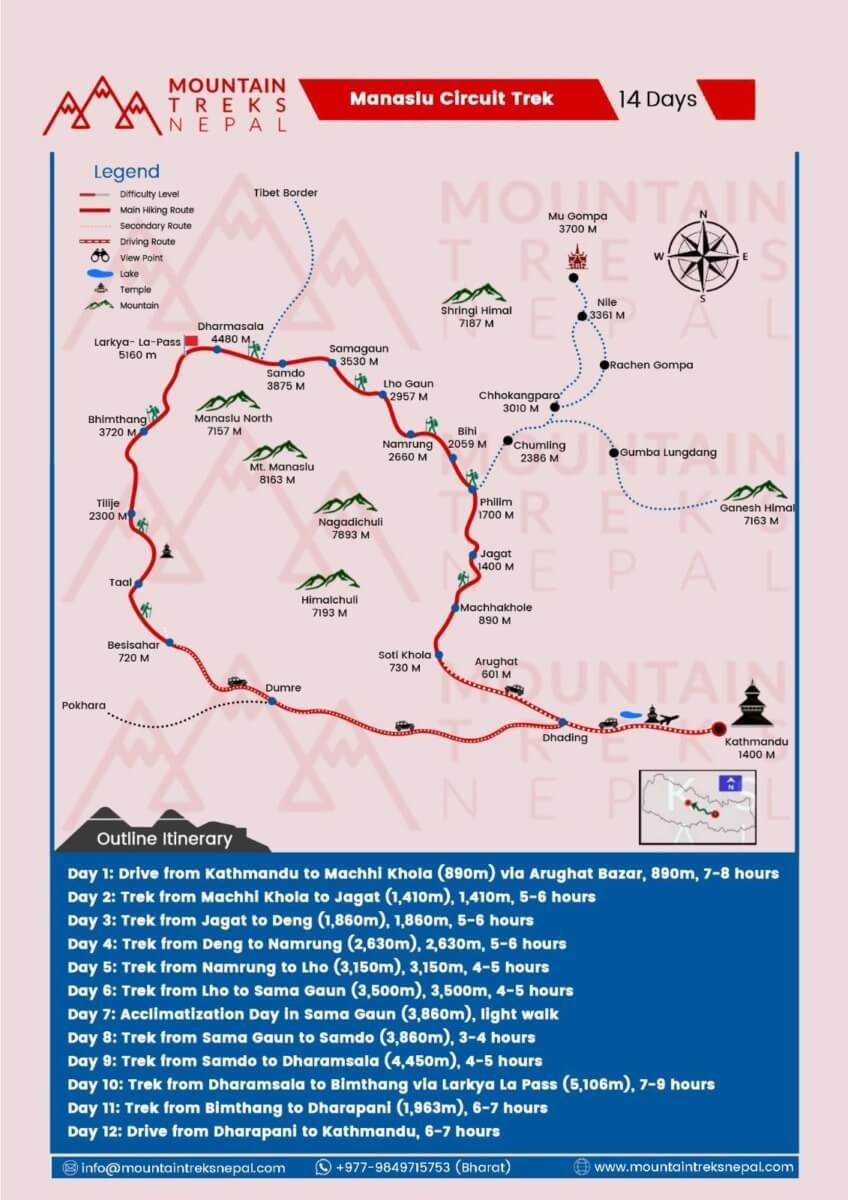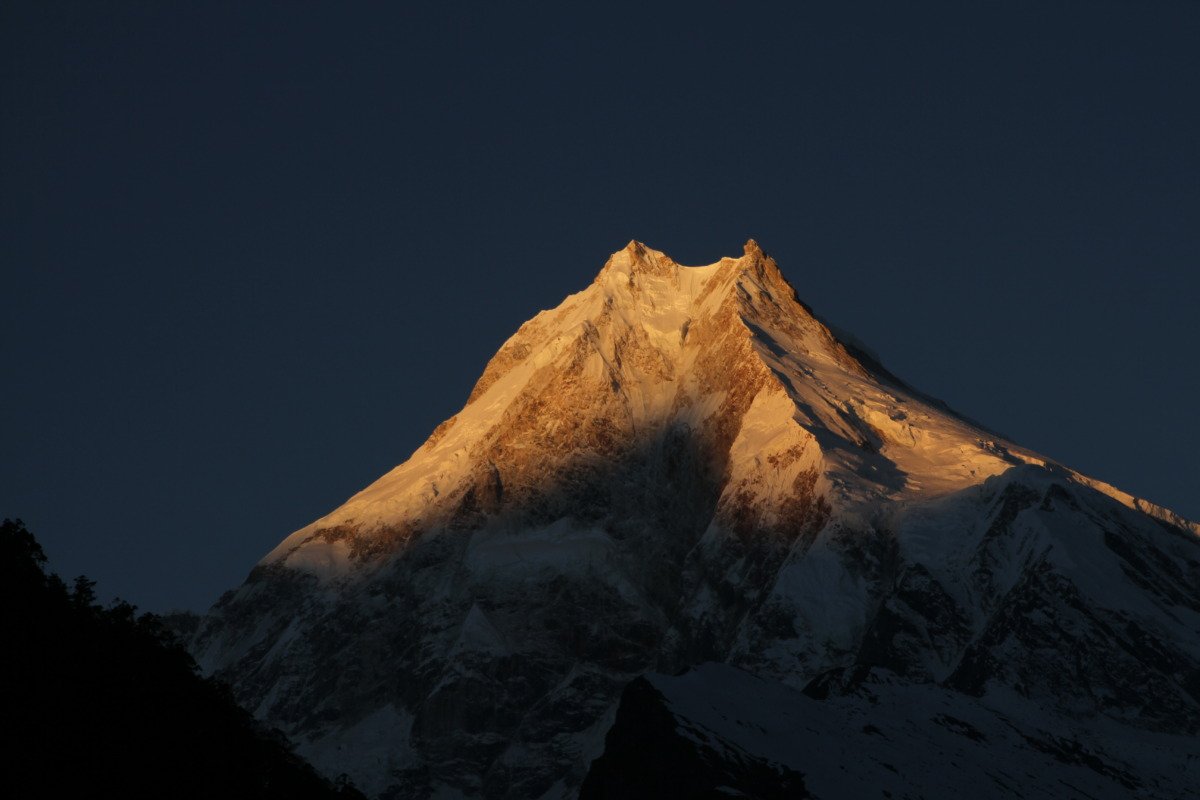Share This:

Manaslu Circuit Trek with Mountain Treks Nepal
Introduction: Why the Manaslu Circuit Trek Should Be on Your Bucket List?
Nestled in western Nepal, the Manaslu Circuit Trek is a majestic journey circling Mount Manaslu (8,163 m) the world’s eighth-highest peak through remote valleys, Tibetan-influenced villages, and over high passes. Although challenging, this trek remains less crowded than the Everest or Annapurna routes, offering a more intimate Himalayan experience.
At Mountain Treks Nepal, we specialize in Manaslu Circuit trekking journeys. We manage every detail permits, logistics, guiding, safety so trekkers can focus on the experience: crossing Larkya La Pass (5,106 m), exploring villages such as Sama, Samdo, and Lho, and soaking in dramatic landscapes.
In this guide, you’ll find everything you need: itinerary, difficulty, permits, tips, comparison with other treks, and why trekking with Mountain Treks Nepal gives you an advantage.
Trek Overview & Route

The Manaslu Circuit Trek is one of Nepal’s most authentic and less-crowded high-altitude treks. It traverses the Manaslu Conservation Area, winding through forests, rivers, alpine meadows, and culminating at Larkya La Pass. The trek ends in the Annapurna-conservation zone, so parts of the route may require ACAP (Annapurna permit).
Typical distance: ~ 170–180 km (round trip, depending on side excursions).
Because the Manaslu region is designated as a restricted area, solo trekking is not permitted. Every trekker must be accompanied by a licensed guide or go with an agency.
This makes the trek safer and more regulated, but it’s also an opportunity to benefit from local expertise (which Mountain Treks Nepal ensures you get).
Suggested Itinerary (14 Days)

Below is a sample 14‑day Manaslu Circuit Trek itinerary. Mountain Treks Nepal can adjust this to your fitness, time, or preferences (e.g. adding more rest days, side-trips to Tsum Valley, etc.).
| Day | From → To | Altitude / Distance | Highlights / Notes |
| 1 | Kathmandu → Drive to Machha Khola | ~ 7–8 hr drive | Scenic hills, rivers, preparation |
| 2 | Machha Khola → Jagat | ~ 1,410 m | Forest trails, gorges, village warm-up |
| 3 | Jagat → Deng | ~ 1,860 m | Crossing rivers, terraced fields |
| 4 | Deng → Namrung | ~ 2,630 m | Tibetan Buddhist influences, views |
| 5 | Namrung → Lho | ~ 3,150 m | Alpine transition, monastery visits |
| 6 | Lho → Sama Gaun | ~ 3,500 m | Panorama of Manaslu, local village life |
| 7 | Acclimatization in Sama Gaun | Rest / side hikes | Let your body adjust |
| 8 | Sama Gaun → Samdo | ~ 3,860 m | Enter high‑altitude zone, moraine paths |
| 9 | Samdo → Dharmasala (Larkya Phedi) | ~ 4,450 m | Final approach to the pass |
| 10 | Dharmasala → Cross Larkya La (5,106 m) → Bimthang | Pass day | Long effort, stunning views |
| 11 | Bimthang → Descent toward Dharapani | ~ 1,963 m | Meadows, forests, downhill |
| 12 | Continue descent / walking | — | Lower altitude trails |
| 13 | Dharapani → Besisahar → Kathmandu (drive) | ~ 7–10 hr | Return journey |
| 14 | Buffer / Departure | — | Rest, explore Kathmandu before leaving |
Notes & variations:
- You may insert extra acclimatization days (e.g. at Samdo or Sama) depending on group fitness
- Some trekkers include a side trip to Manaslu Base Camp, Birendra Lake, or even Tsum Valley (adds several days
- Jeep or bus transport may replace final walking legs on some days
Trek Difficulty & Altitude Considerations

Difficulty Rating
The Manaslu Circuit is categorized as moderate to strenuous. You’ll walk 5–8 hours most days, with steep sections, loose terrain, and high passes. The most demanding day is crossing Larkya La.
Altitude & Acclimatization
Since you ascend above 5,000 meters, altitude sickness (AMS) is a real concern. Even physically strong trekkers can have symptoms. Common symptoms include headache, nausea, dizziness, loss of appetite, fatigue, and insomnia.
Prevention strategies:
- Hydrate frequently (4–5+ liters per day)
- Ascend slowly (“climb high, sleep low”)
- Adequate rest and acclimatization days (e.g. at Sama or Samdo)
- Avoid alcohol, too much caffeine, heavy exertion at high altitude
- Use Diamox (acetazolamide) only under medical advice
Your guide should carry a pulse oximeter, oxygen, and first-aid equipment. Mountain Treks Nepal ensures these safety measures are in place.
If symptoms worsen significantly, stop ascending or descend immediately don’t ignore signs of serious AMS.
Best Time to Do the Manaslu Circuit Trek
Choosing the right season is critical for safe, beautiful trekking. The best windows are:
- Spring (March to May) — Rhododendron bloom, moderate weather, good visibility
- Autumn (September to November) — Clear skies, stable weather, dry trails
Avoid monsoon (June–August) heavy rain, slippery trails, risk of landslides.Winter (December to February) is possible only for very experienced trekkers; many high passes are blocked by snow, lodges may be closed, nights are extremely cold.
When you trek with Mountain Treks Nepal, we choose departure dates inside these optimal windows and remain flexible in adjusting for weather conditions.
Permits & Trail Regulations
Because Manaslu is a restricted area, the permit system is more complex than many treks. The required permits generally include:
- Manaslu Restricted Area Permit (RAP) — cost depends on season; required for entry into restricted zones.
- Manaslu Conservation Area Permit (MCAP) — fixed cost for conservation area access.
- Annapurna Conservation Area Permit (ACAP) — needed for parts of the descent that enter Annapurna Conservation zones.
- TIMS (Trekkers’ Information Management System) Card — may be required when entering Annapurna region segments.
- Additional local municipality permits (e.g. Chumnubri Rural Municipality) — in some recent regulations.
Your trekking agency (or guide) usually secures and pays for these permits. Mountain Treks Nepal handles all permit logistics for your comfort and compliance.
Gear, Accommodation & Logistics
Accommodation & Food
You’ll stay in teahouses / guesthouses along the trail. At lower altitudes, facilities are more comfortable; at higher elevations, they become basic (shared bathrooms, simple bedding).
Meals: typically Nepali and Tibetan staples like dal bhat, noodles, momo, soups. Garlic soup is often offered higher up for its believed aiding effect on acclimatization.
Electricity & Connectivity
- Charging: In many teahouses in lower and mid sections, you can charge your electronics for a fee (300–700 NPR or more).
- In high-altitude stops (e.g. Dharmasala), power may not exist bring power banks or solar chargers.
- Mobile signals (Nepal Telecom / NTC) are available in lower villages, but unreliable at high altitude.
- Some lodges may offer Wi-Fi (paid, slow) in lower segments.
Packing & Gear Checklist
Essentials include:
- Daypack (35–45 L) with rain cover
- Waterproof and windproof jacket / pants
- Insulating layers: fleece, down jacket
- Base thermal layers
- Trekking trousers, warm under-layers
- Waterproof hiking boots, gaiters
- Gloves (liner + outer), warm hat, buff / neck gaiter
- Sunglasses, sunscreen, lip balm
- Trekking poles
- Water bottles / hydration system
- Water purification (tablets or filter)
- First-aid kit, blister care
- Headlamp + spare batteries
- Passport, permits, insurance copies
- Power bank / solar charger
- Light towel, toiletries
- Snacks / energy bars
You can often rent heavier gear in Kathmandu, but bring all essentials yourself.
Culture, Villages & Scenic Highlights
One of the richest parts of the Manaslu Circuit is its cultural and scenic depth:
- Villages & monasteries: Lho, Sama, Samdo all have Tibetan Buddhist influences, prayer flags, mani walls, and local monasteries.
- Birendra Lake, Pungyen Gompa: optional side detours adding spiritual and scenic value.
- Larkya La Pass: Panoramic views of Manaslu, Cheo Himal, Himlung Himal, Kang Guru, Annapurna II.
- Forest-to-alpine transitions: walk through rhododendron, oak, pine forests into alpine meadows and snow fields.
- Fauna & flora: in the Manaslu Conservation Area, you may spot Himalayan tahr, blue sheep, birds, and unique alpine plants.
- Cultural immersion: engage with local customs, respect monasteries, dress modestly, observe daily life.
These immersive cultural experiences are not just side attractions — they are part of the Manaslu Circuit Trek’s magic.
Manaslu Circuit vs Annapurna / Everest Treks
Here’s how Manaslu compares:
| Feature | Manaslu Circuit | Annapurna Circuit | Everest Base Camp |
| Crowds | Less crowded, more solitude | Busy, well trodden | Very busy, especially near base camps |
| Technicality | Moderate‑strenuous, high pass | Moderate, well-built trails | Moderate, glacier approaches if climbing |
| Cultural density | Strong Tibetan Buddhist influence | More diverse Hindu / Buddhist mix | Sherpa / Himalayan culture |
| Permits / restrictions | Restricted area – must go with guide | Open access in many parts | Open, but permits required |
| Scenic variation | Remote forests → alpine → snow passes | Terraced fields, rain shadow, desert landscapes | High glacial valleys, Himalayan giants |
| Best Season | Spring & Autumn | Spring, Autumn, also Summer edges | Spring, Autumn mostly |
Manaslu gives a quieter, more intimate Himalayan trek with strong cultural ambiance, whereas Annapurna and Everest are more developed and heavily traveled.
If your aim is authenticity and fewer crowds, Manaslu is a compelling choice.
Tips for a Successful Manaslu Trek
- Start fitness training early: cardio, hill walking, back with weight
- Pack light: let porters carry heavier loads
- Pace yourself — slow and steady beats rushing
- Hydrate & eat small, frequent meals
- Use acclimatization days properly — take local hikes, rest
- Be flexible — weather or altitude may force schedule changes
- Respect local culture — modest dress, remove shoes in homes/monasteries
- Carry small cash in Nepali rupees — remote villages may not accept cards
- Tip your guide and porters — as gesture of gratitude
- Listen to your body — report any altitude symptoms early
Many seasoned trekkers and guides consider good sleep (7–8 hours) essential for high-altitude success.
Why Trek with Mountain Treks Nepal?
Choosing a local, experienced operator makes a huge difference. Here’s what Mountain Treks Nepal offers:
- Total logistical support: we manage permits (RAP, MCAP, ACAP, TIMS), transport, accommodation, contingency plans
- Safety first: guides carry oxygen, pulse oximeters, first-aid, emergency protocols
- Deep local knowledge: guiding, culture, acclimatization, weather patterns
- Custom flexibility: we can adjust itineraries, include Tsum Valley or base-camp detours
- Ethical & sustainable practices: we partner with villages, minimize waste, support local economy
- Reputation & reviews: many past trekkers praise our professionalism, support, and care
When you trek with us, you benefit from local insight, smoother logistics, and peace of mind.
Frequently Asked Questions (FAQ)
Is Manaslu Circuit Trek suitable for beginners?
With preparation, yes for trekkers in good physical shape who acclimatize properly and travel with guides. It’s more demanding than casual treks.
How long is the trek?
Typical itineraries are 12–14 days. If you include side trips (Tsum Valley, Base Camp) it can stretch to 18–22 days.
What is the approximate cost?
Guided, all-inclusive packages often range between USD 700–1,100, depending on group size, season, and inclusions.
Can I trek independently?
No. Solo trekking in the Manaslu restricted area is prohibited. You must have a licensed guide.
What if weather or acclimatization forces changes?
Good guides adjust the itinerary, delay or reroute as needed. Evacuation is possible in emergencies.
Can I extend into Tsum Valley?
Yes, Mountain Treks Nepal can build in that extension. It adds a deeper cultural and scenic dimension.
Conclusion & Call to Action
The Manaslu Circuit Trek is a journey not only through mountains but through traditions, time, and your inner strength. For those seeking solitude, authenticity, and raw Himalayan beauty, it’s among Nepal’s finest.
But the trek’s complexity permits, logistics, altitude, weather means that choosing the right operator is essential. At Mountain Treks Nepal, we back your journey with local expertise, full support, safety, and flexibility.
Ready to start planning your Manaslu Circuit Trek? Contact us today, and we’ll design the perfect itinerary to match your fitness, timeline, and dreams. Let us carry the logistics you carry the adventure.
